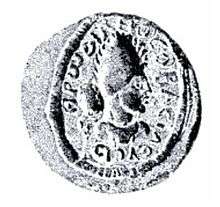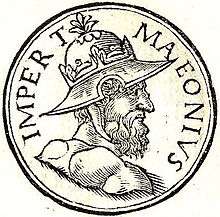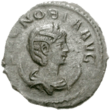List of Palmyrene monarchs
Below is the list of Palmyrene monarchs, the monarchs that ruled and presided over the city of Palmyra and the subsequent Palmyrene Empire in the 3rd century AD, and the later vassal princes of the Al Fadl dynasty which ruled over the city in the 14th century.
House of Odaenathus
Odaenathus, the lord of Palmyra, declared himself king before riding into battle against the Sassanians after news of the Roman defeat at Edessa reached him.[1] This elevated Palmyra from a subordinate city to a de facto independent kingdom allied to Rome.[2]
Odaenathus later elevated himself to the title of King of Kings, crowning his son co-King of Kings in 263.[3] The title was later passed to Vaballathus his son, before it was dropped for the title of King[4] and later Emperor.
| Portrait | Name | Ruler From | Ruler Until | Relationship with Predecessor(s) | Title | Notes |
|---|---|---|---|---|---|---|
 |
Odaenathus | 260 | 267 | King King of Kings |
Founder of the Palmyrene monarchy, dropped the King title and started using King of Kings by 263 | |
 |
Hairan I | 263 | 267 | • Son of Odaeanthus | King of Kings | Made co-King of Kings by his father.[5] |
 |
Maeonius | 267 | 267 | • Odaenathus' cousin.[6] | Emperor | No evidence exist for his reign,[7] but he allegedly murdered Odaenathus and his son, Hairan and attempted a usurpation |
.jpg) |
Vaballathus | 267 | 272 | • Son of Odaenathus | King of Kings King Emperor |
Dropped the "King of Kings" title in 270, replacing it with the Latin rex (king) and declared emperor in 271.[4] Reigned under the regency of his mother, Zenobia.[8] |
 |
Zenobia | 267 | 272 | • Mother of Vaballathus | Queen Empress |
Ruled as a regent for her children and did not claim to rule in her own right.[8] |
| Antiochus | 273 | 273 | • Possibly a son of Zenobia.[9] | Emperor |
Al Fadl dynasty
| Ruler | Reigned | Title | Notes |
|---|---|---|---|
| Sharaf ad-Din Issa | 1281–1284 | Prince | Appointed as a reward for aiding the Mamluks.[10] |
| Husam ad-Din Muhanna | 1284–1293 | Prince | Imprisoned by the Mamluks.[11] |
| Husam ad-Din Muhanna | 1295–1312 | Prince | Second reign.[11] |
| Fadl ibn Isa | 1312–1317 | Prince | Brother of Muhanna.[11] |
| Husam ad-Din Muhanna | 1317–1320 | Prince | Expelled with his tribe.[11] |
| Husam ad-Din Muhanna | 1330–1335 | Prince | Fourth reign.[11] |
| Muzaffar al-Din Musa | 1335–1341 | Prince | Son of Muhanna.[12] |
| Suleiman I | 1341–1342 | Prince | Son of Muhanna.[13] |
| Sharaf al-Din Issa | 1342–1343 | Prince | Son of Fadl bin Issa.[13] |
| Saif | 1343–1345 | Prince | Son of Fadl bin Issa.[13] |
| Ahmad | 1345–1347 | Prince | Son of Muhanna.[14] |
| Saif | 1347–1348 | Prince | Second reign.[14] |
| Ahmad | 1348 | Prince | Second reign.[14] |
| Fayad | 1348 | Prince | Son of Muhanna.[15] |
| Hayar | 1348–1350 | Prince | Son of Muhanna.[15] |
| Fayad | 1350–1361 | Prince | Second reign.[15] |
| Hayar | 1361–1364 | Prince | Second reign; rebelled and was dismissed.[13][15] |
| Zamil | 1364–1366 | Prince | Son of Muhanna's brother Musa.[13] |
| Hayar | 1366–1368 | Prince | Third reign; rebelled and was dismissed.[16] |
| Zamil | 1368 | Prince | Second reign; rebelled and was dismissed.[16] |
| Mu'ayqil | 1368-1373 | Prince | Son of Fadl bin Issa.[16] |
| Hayar | 1373–1375 | Prince | Fourth reign.[16] |
| Malik | 1375–1379 | Prince | Son of Muhanna.[16] |
| Zamil | 1379–1380 | Prince | Third reign; ruled with Mu'ayqil.[16] |
| Mu'ayqil | 1379–1380 | Prince | Second reign; ruled with Zamil.[16] |
| Nu'air bin Hayar | 1380– | Prince | Son of Hayar.[16] |
| Musa | –1396 | Prince | Son of Hayar's brother Assaf.[16] |
| Suleiman II | 1396–1398 | Prince | Son of Hayar's brother 'Anqa.[17] |
| Muhammad | 1398–1399 | Prince | Brother of Suleiman II.[18] |
| Nu'air bin Hayar | 1399–1406 | Prince | Second reign.[18] |
References
- Dignas, Beate; Winter, Engelbert (2007) [2001]. Rome and Persia in Late Antiquity: Neighbours and Rivals. Cambridge University Press. p. 159. ISBN 978-0-521-84925-8.
- Young, Gary K. (2003) [2001]. Rome's Eastern Trade: International Commerce and Imperial Policy 31 BC - AD 305. Routledge. p. 159. ISBN 978-1-134-54793-7.
- Udo Hartmann (2001). Das palmyrenische Teilreich (in German). p. 178.
- Andrew M. Smith II (2013). Roman Palmyra: Identity, Community, and State Formation. p. 179.
- Maurice Sartre (2005). The Middle East Under Rome. p. 353.
- Trevor Bryce (2014). Ancient Syria: A Three Thousand Year History. p. 292.
- George C. Brauer (1975). The Age of the Soldier Emperors: Imperial Rome, A.D. 244-284. Noyes Press. p. 163.
- Pat Southern (2008). Empress Zenobia: Palmyra's Rebel Queen. p. 92.
- Alaric Watson (2004). Aurelian and the Third Century. p. 81.
- محمد عدنان قيطاز (1998). "مهنّا (أسرة)". الموسوعة العربية (in Arabic). 19. هيئة الموسوعة العربية. p. 788. Archived from the original on 2016-08-02. Retrieved 2015-11-17.
- Khayr al-Dīn Ziriklī (1926). al-Aʻlām,: qāmūs tarājim al-ashʾhur al-rijāl wa-al-nisāʾ min al-ʻArab wa-al-mustaʻrabīn wa-al-mustashriqīn, Volume 7 (in Arabic). p. 73.
- Yūsuf al-Atābikī Ibn Taghrī Birdī (1451). al-Manhal al-ṣāfī wa-al-mustawfá baʻda al-wāfī (in Arabic). p. 373.
- Ibn Khaldūn (1375). Kitāb al-ʻibar wa-dīwān al-mubtadaʾ wa-al-khabar f̣ī ayyām al-ʻArab wa-al-ʻAjam ẉa-al-Barbar wa-man ʻāṣarahum min dhawī al-sulṭān al-al-akbar wa-huwa tarīkh waḥīd ʻaṣrih, Volume 5 - Part 30 (in Arabic). p. 105.
- Khalīl ibn Aybak Ṣafadī (1363). al-Wāfī bi-al-Wafayāt Vol.28 (in Arabic). p. 345.
- Khalīl ibn Aybak Ṣafadī (1363). al-Wāfī bi-al-Wafayāt Vol.7 (in Arabic). p. 192.
- Ibn Khaldūn (1375). Kitāb al-ʻibar wa-dīwān al-mubtadaʾ wa-al-khabar f̣ī ayyām al-ʻArab wa-al-ʻAjam ẉa-al-Barbar wa-man ʻāṣarahum min dhawī al-sulṭān al-al-akbar wa-huwa tarīkh waḥīd ʻaṣrih, Volume 6 - Part 11 (in Arabic). p. 11.
- Yūsuf al-Atābikī Ibn Taghrī Birdī (1451). al-Manhal al-ṣāfī wa-al-mustawfá baʻda al-wāfī, Volume 6 (in Arabic). p. 48.
- Aḥmad Ibn-ʻAlī Ibn-ʻAbdalqādir al- Maqrīzī (1441). as-Sulūk li-maʻrifat duwal al-mulūk (in Arabic). p. 801.
This article is issued from Wikipedia. The text is licensed under Creative Commons - Attribution - Sharealike. Additional terms may apply for the media files.